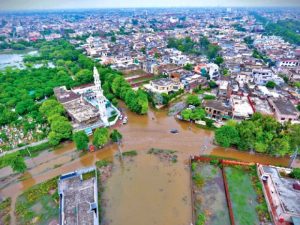The death toll from the monsoon season that has caused flooding, landslides, and the collapse of roofs and walls across the country this month has risen to 50, with at least six additional deaths reported from Punjab on Friday.

Official data showed that the bulk of fatalities happened in the province of Punjab, specifically as a result of electrocution and building collapses. Eight children were found dead in the Shangla district of Khyber-Pakhtunkhwa after a landslip on Thursday.
An spokesman from Pakistan’s National Disaster Management Authority (NDMA) told AFP that “fifty deaths have been reported in different rain-related incidents all over Pakistan since the start of the monsoon on June 25,” with an additional 87 persons being injured.
It rained so heavily on Wednesday in Lahore, Pakistan’s second largest city, that officials said roadways had been transformed into rivers and about 35% of the population was without access to running water and electricity.
On July 3, when the monsoon began to make landfall, torrential rains began in the mountainous regions. On July 5, record-breaking 291 mm of rain fell in Lahore, killing at least seven people.
Six additional persons have died in the last day in Punjab, according to the Provincial Disaster Management Authority (PDMA).
A PDMA spokesman said that two people in Sheikhupura and two people in Faisalabad died as a result of the rain, while in Jhang and Khushab, one person died. The spokesperson also confirmed that seven additional people were hurt.
Islamabad and Rawalpindi, Pakistan’s twin towns, have been getting pounded by heavy rains for the past few days. After the downpour, water levels in Nullah Lai increased by seven feet. Authorities, including the military, were on high alert because of the flooding in the nullah.
Rawalpindi and Islamabad, Pakistan’s twin towns, received 29 millimetres of rain, while adjacent Syedpur got 14, Golra got 41, Shamsabad got 13, and Chaklala got 24.
On Thursday, a landslip in the Shangla district of K-P buried eight children. On Friday, Bilal Ahmed Faizi, a representative for K-P Rescue 1122, said that the hunt for further youngsters who may be buried under the rubble was ongoing.
Another landslip slammed a vehicle at Zero Point on the Bisham-Swat Road close to the Ranyal region, killing one and injuring another, according to the deputy commissioner of Shangla.
He further revealed that the killed and injured were on their way from Bisham to Swat.
Balakot and the surrounding area, as well as the nearby Kaghan Valley, had persistent heavy rain and a hailstorm, which led to flooding along the Kunhar River and other streams in the province.
The highway between the federal capital with Gilgit-Baltistan was also cut off by the floods. An official with the National Highway Administration (NHA) said that as a result, some travellers were left stranded along the Karakoram Highway.
The official reported that the Frontier Works Organisation (FWO) was clearing the Karakoram Highway of obstructions at Jijal, Pattan, Uchar Nullah, and other locations.
They also promised to open alternative routes.
A long pause
The PMD predicted last week that the current rainy weather would continue through July 8 (today).
However, an update released on Friday predicted that precipitation will persist through July 10.
It warned of potential flooding in the riverine catchment areas due to the severe rainfall forecasted for the entire country, including further rain in Lahore this afternoon.
The PDMA has stated its intention to relocate residents of low-lying areas near rivers.
Between June and September, the summer monsoon gives South Asia 70-80% of its yearly rainfall.
It’s crucial for the economic stability of millions of farmers and the safety of the food supply in an area home to around two billion people. But with it comes the risk of flooding and landslides.
Unprecedented monsoon downpours last summer flooded a third of the country, destroying 2 million homes and killing over 1,700 people.
Climate warming, according to scientists, is increasing the intensity and unpredictability of seasonal rainfall.









































